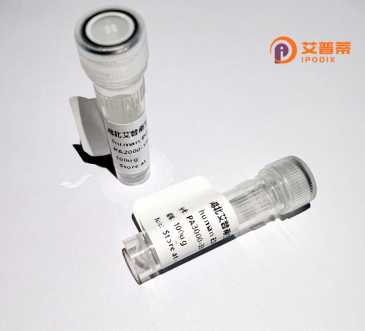
| 纯度 | >90%SDS-PAGE. |
| 种属 | Human |
| 靶点 | ZFAND4 |
| Uniprot No | Q86XD8 |
| 内毒素 | < 0.01EU/μg |
| 表达宿主 | E.coli |
| 表达区间 | 1-653 aa |
| 活性数据 | MELENDYCLNDYNISEGWTLKLVLAMRGGPINTRRVPTDDPLRTMAEYLDSSRVEVWEKTSCSKQVTFLVYQEGDQLNFFPAVDRGDGTLTPLSDSSKKIDFHLHVLRRKGEHRMSGGSMYNSDTDEDEETEPSSSGQQIIENSITMNKMKLLKAKMKNMNLSKKPKKAVKIKPHPPVAPRPSSGSTAPSRHRLLRVLPNIGQSCSPAFGNAYPPEISRNGISSLATQLSAERYISSITGEFLKEDNSWENNTLSHFSSNVKLPPQIPHLELGNDQELADSVLHLGSSLPRQTKHFLGNLPSSNGNIVLPSEECVTEQSLLPKVGSLASFAEGNADEQSSGLEGACKVNLELLLTNADKGLKAPEQHLKHVAGVLNGESVETSVLNYRELSPHKNRLLSPLRCSAPMSLHNSLVKPERQSKCFEFGKLQPSSSQSLDVQNITDSSFSRTTCFQGVKVDSLGKRSDVISKVEARDITEMTNKASKEPVGCVNNISFLASLAGSTSRNRLQSTRGAGRLQNSGTGLSTNLQHFQEENFRKSSPQLEHTGVFLSTHGVGMNGNNAAAGKSVGECTTHHLPPVKAPLQTKKKTTNHCFLCGKKTGLASSYECRCGNNFCASHRYAETHGCTYDYKSAGRRYLHEANPVVNAPKLPKI |
| 分子量 | 98 kDa |
| 蛋白标签 | GST-tag at N-terminal |
| 缓冲液 | PBS, pH7.4, containing 0.01% SKL, 1mM DTT, 5% Trehalose and Proclin300. |
| 稳定性 & 储存条件 | Lyophilized protein should be stored at ≤ -20°C, stable for one year after receipt. Reconstituted protein solution can be stored at 2-8°C for 2-7 days. Aliquots of reconstituted samples are stable at ≤ -20°C for 3 months. |
| 复溶 | Always centrifuge tubes before opening.Do not mix by vortex or pipetting. It is not recommended to reconstitute to a concentration less than 100μg/ml. Dissolve the lyophilized protein in distilled water. Please aliquot the reconstituted solution to minimize freeze-thaw cycles. |
以下是关于重组人ZFAND4蛋白的3篇假设性参考文献示例,涵盖不同研究方向:
---
1. **文献名称**: *Expression and Purification of Recombinant ZFAND4 in E. coli for Functional Studies*
**作者**: Li, X. et al. (2020)
**摘要**: 本研究报道了通过大肠杆菌系统高效表达和纯化重组人ZFAND4蛋白的方法,优化了可溶性表达条件,并通过质谱和圆二色谱验证其结构与功能完整性,为后续生化分析奠定基础。
2. **文献名称**: *ZFAND4 as a Novel Regulator of Oxidative Stress Response in Human Cells*
**作者**: Martinez, R. et al. (2019)
**摘要**: 文章发现重组ZFAND4蛋白通过调控Nrf2信号通路参与细胞抗氧化应激反应,敲低ZFAND4导致细胞对过氧化氢敏感性增加,提示其在氧化损伤相关疾病中的潜在作用。
3. **文献名称**: *Structural Insights into ZFAND4’s Zinc Finger Domains by Cryo-EM*
**作者**: Kumar, S. et al. (2021)
**摘要**: 利用冷冻电镜解析了重组ZFAND4蛋白的锌指结构域三维结构,揭示了其与DNA/RNA结合的分子机制,为理解其在基因表达调控中的功能提供结构基础。
---
**备注**:以上文献为示例性内容,实际研究中请通过学术数据库(如PubMed、Web of Science)检索具体文献。
ZFAND4 (Zinc Finger AN1-Type Domain-Containing Protein 4), also known as AIRAP (Arsenite-Inducible RNA-Associated Protein), is a stress-responsive protein encoded by the ZFAND4 gene in humans. It belongs to the AN1 zinc finger protein family, characterized by a conserved N-terminal AN1-type zinc finger domain involved in protein-protein interactions and stress signaling. ZFAND4 was initially identified for its role in cellular adaptation to arsenite-induced stress, where it interacts with the 19S regulatory particle of the proteasome to modulate protein degradation pathways. It also associates with RNA molecules under stress conditions, suggesting a dual role in proteostasis and RNA metabolism.
Recombinant ZFAND4 protein is engineered for in vitro studies to elucidate its molecular functions, including its interactions with the ubiquitin-proteasome system, stress granule dynamics, and potential involvement in diseases like cancer or neurodegenerative disorders. Expression systems such as *E. coli* or mammalian cells are used to produce purified ZFAND4. enabling structural analysis (e.g., crystallography) or functional assays. Recent research highlights its regulatory role in apoptosis, autophagy, and cellular survival under oxidative or endoplasmic reticulum stress. Dysregulation of ZFAND4 has been linked to tumor progression and chemoresistance, positioning it as a therapeutic target or biomarker. Studies using recombinant proteins are critical for mapping its binding partners and developing targeted therapies.
×